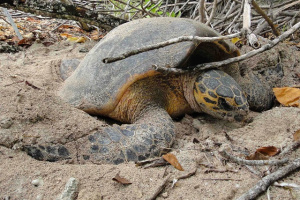Sea turtle population stable in Seychelles despite ongoing poaching incidents
Species |Author: Daniel Laurence Edited by: Betymie Bonnelame | June 12, 2020, Friday @ 14:09| 13651 views
The hawksbill turtle which breeds mostly between mid-October and mid-January is classified as critically endangered. (Jeanne Mortimer)
(Seychelles News Agency) - The population of sea turtles in the Seychelles' waters is stable despite continuous poaching incidents, said a top environment official.
The director of conservation in the Department of Environment, Ashley Dias, said the sea turtles "continue to thrive within the Seychelles' waters, especially on and around the main islands where most of the population are."
Dias told SNA that during the nesting season the authorities recorded 64 hawksbill and six green turtle nests "but we think that not all might have had successful hatchlings as we have observed broken eggs at some sites and we cannot say if they've survived."
Seychelles, an archipelago in the western Indian Ocean, is home to one of the world's largest populations of green and hawksbill turtle.
The green turtle breeds all over the islands throughout the year, unlike the hawksbill turtle which breeds mostly between mid-October and mid-January. Both species are on the International Union for Conservation of Nature's (IUCN) red list. Green turtles are classified as endangered while the hawksbills are critically endangered.
Dias said that more poaching is occurring in the southern part of the main island of Mahe because the beaches are more isolated and out of sight, making it easier for poachers to go undetected.
Earlier this week, the Seychelles National Parks Authority (SNPA) which works in collaboration with a non-governmental organisation, Global Vision International (GVI), reported cases of poaching at Cap Ternay in the western Mahe district of Port Glaud.
 |
| It was one of the staff of the Global Vision International (GVI) who discovered the remains of a sea turtle. (Seychelles Nation) Photo license: CC-BY |
Gilberte Gendron, the marine operations coordinator at SNPA, told the press that "it was one of their staff who discovered the remains of a sea turtle. The way the remains were scattered on the rocks definitely shows that it was not something brought by the waves but poached by humans."
She added that this is not the first case that SNPA has received.
"During the COVID-19 lockdown, we noticed a few cases. Currently, only our staff are on patrols and the poachers know our schedules. For the moment we have two concrete cases and we have to note that we are not yet in the nesting period. Unfortunately, these cases concern mainly juvenile turtles," said Gedeon.
Currently, an investigation is ongoing in a case of unlawful possession of sea turtle meat found on a vessel which was intercepted in the Seychelles’ waters on May 9.
According to the environment department, there have been 15 confirmed cases of poaching this season. For the whole of last year, 14 cases were recorded while in 2018 there were only eight cases.
Consequently, the Department of Environment is inviting interested people to join the campaign against poaching and volunteer in the upcoming sea turtle monitoring programme.
Dias said that already members of the public have been very supportive of the work done during monitoring.
"We have noticed an increase in the number of people who are reporting poaching incidents to us. We have had a great collaboration with the South Police Station, who assisted us whenever we needed their help," she said.
Sea turtles in Seychelles are protected under the Wild Animals and Birds Protection Act and the penalty for offences is up to two years in prison and a fine of up to $37,000. In spite of the strict laws, poaching is still a major concern because of the country's tradition of eating turtle meat as a delicacy. In most cases, because they are the ones that lay eggs, females are more vulnerable.
"It is very difficult to know the exact date the eggs will hatch. We can provide an estimate. Staff monitor the nests during nesting season and we advise members of the public who live close to the nests to keep an eye on their dogs," said Dias.
Sea turtles lay around 150 to 200 eggs depending on species and that takes around two to three hours. The hatchlings will emerge after eight weeks of incubation.
Back
